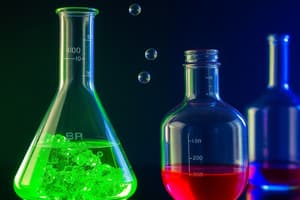Podcast
Questions and Answers
Which process exemplifies a physical change, where the substance's chemical identity remains unaltered?
Which process exemplifies a physical change, where the substance's chemical identity remains unaltered?
- Melting of an ice cube on a warm day. (correct)
- Combustion of propane in a gas grill.
- Reaction of hydrochloric acid with zinc to produce hydrogen gas.
- Electrolysis of water into hydrogen and oxygen.
Which observation definitively suggests that a chemical change has occurred?
Which observation definitively suggests that a chemical change has occurred?
- Mixing two clear solutions results in the formation of a cloudy solid. (correct)
- The volume of a gas increases when it is heated in a sealed container.
- A solid dissolves completely when added to a solvent.
- A substance changes from a liquid to a gas at its boiling point.
When iron rusts, it combines with oxygen to form iron oxide. Which statement accurately describes this process?
When iron rusts, it combines with oxygen to form iron oxide. Which statement accurately describes this process?
- A physical change, because the process can be reversed by removing the oxygen.
- A chemical change, because a new substance with different properties is formed. (correct)
- A physical change, because the iron's appearance changes but its composition remains.
- A chemical change, because the mass of the iron remains constant throughout the process.
Which scenario involves only physical changes?
Which scenario involves only physical changes?
Why is dissolving sugar in water considered a physical change, not a chemical change?
Why is dissolving sugar in water considered a physical change, not a chemical change?
Which activity primarily involves a chemical change?
Which activity primarily involves a chemical change?
Which of the following indicates that a chemical reaction is likely taking place?
Which of the following indicates that a chemical reaction is likely taking place?
A student observes bubbles forming when mixing two clear liquids in a beaker. What type of change is MOST likely occurring?
A student observes bubbles forming when mixing two clear liquids in a beaker. What type of change is MOST likely occurring?
Which of the following observations would best indicate that a chemical reaction has occurred?
Which of the following observations would best indicate that a chemical reaction has occurred?
When hydrochloric acid (HCl) reacts with sodium hydroxide (NaOH), heat is released, and a salt (NaCl) and water are produced. Which statement best describes this reaction?
When hydrochloric acid (HCl) reacts with sodium hydroxide (NaOH), heat is released, and a salt (NaCl) and water are produced. Which statement best describes this reaction?
Which of the following scenarios best illustrates the principle of conservation of mass?
Which of the following scenarios best illustrates the principle of conservation of mass?
Which of the following processes is least likely to be reversible by simple physical means?
Which of the following processes is least likely to be reversible by simple physical means?
Which of the following best exemplifies a chemical change?
Which of the following best exemplifies a chemical change?
A student mixes two clear solutions in a beaker. The beaker becomes significantly colder, and a solid precipitate forms. Which of the following conclusions is most justified?
A student mixes two clear solutions in a beaker. The beaker becomes significantly colder, and a solid precipitate forms. Which of the following conclusions is most justified?
Consider a scenario where methane ($CH_4$) is burned in the presence of oxygen ($O_2$). What are the products of this reaction, and what type of change is it?
Consider a scenario where methane ($CH_4$) is burned in the presence of oxygen ($O_2$). What are the products of this reaction, and what type of change is it?
Which of the following provides the best evidence that dissolving sugar in water is a physical change, not a chemical change?
Which of the following provides the best evidence that dissolving sugar in water is a physical change, not a chemical change?
Why is the separation of a compound into its constituent elements considered a chemical change, while the separation of a mixture is a physical change?
Why is the separation of a compound into its constituent elements considered a chemical change, while the separation of a mixture is a physical change?
A student puts a metal object in a strong magnetic field and observes that the object becomes magnetized. When the magnetic field is removed, the object gradually loses its magnetism. Which type of change has occurred, and why?
A student puts a metal object in a strong magnetic field and observes that the object becomes magnetized. When the magnetic field is removed, the object gradually loses its magnetism. Which type of change has occurred, and why?
Flashcards
Gas Production
Gas Production
Release of gas bubbles when substances mix, indicating a chemical reaction.
Temperature Change
Temperature Change
Reactions releasing heat (exothermic) or absorbing heat (endothermic), causing temperature change.
Emission of Light
Emission of Light
Light emitted during a chemical reaction.
Physical Change
Physical Change
Signup and view all the flashcards
Chemical Change
Chemical Change
Signup and view all the flashcards
Conservation of Mass
Conservation of Mass
Signup and view all the flashcards
Exothermic Reaction
Exothermic Reaction
Signup and view all the flashcards
Endothermic Reaction
Endothermic Reaction
Signup and view all the flashcards
Mixture
Mixture
Signup and view all the flashcards
Compound
Compound
Signup and view all the flashcards
Change of State (Physical)
Change of State (Physical)
Signup and view all the flashcards
Dissolving (Physical Change)
Dissolving (Physical Change)
Signup and view all the flashcards
Rusting (Chemical Change)
Rusting (Chemical Change)
Signup and view all the flashcards
Cooking (Chemical Change)
Cooking (Chemical Change)
Signup and view all the flashcards
Color Change (Chemical)
Color Change (Chemical)
Signup and view all the flashcards
Precipitate Formation (Chemical)
Precipitate Formation (Chemical)
Signup and view all the flashcards
Study Notes
- Physical and chemical changes are fundamental concepts in chemistry and physics that describe how matter can be altered.
Physical Change
- A physical change alters the form or appearance of a substance, but not its chemical composition.
- The chemical composition of the substance remains the same.
- Physical changes are often reversible, allowing the substance to return to its original form.
- Examples include changes in state (solid to liquid to gas), changes in size or shape (cutting paper, crushing a can), and dissolving.
- Change of state: Substance changes from one state to another (ice melting into water, water boiling into steam), chemical identity remains the same (H2O).
- Dissolving: A substance dissolves in another (sugar dissolving in water), it forms a mixture, but the individual components retain their original properties; the sugar is still sugar, and the water is still water.
- Deformation: Changes like bending a metal rod or crushing a rock are physical because the chemical makeup of the metal or rock doesn't change.
Chemical Change
- A chemical change, known as a chemical reaction, involves the rearrangement of atoms and molecules to form new substances.
- The chemical composition of the substance changes, resulting in the formation of a new substance with different properties.
- Chemical changes are generally irreversible, making it difficult to recover the original substance.
- Examples include burning, rusting, cooking, and reactions that produce a gas, precipitate, or color change.
- Burning: Wood reacts with oxygen to produce carbon dioxide, water vapor, ash, and heat, converting the original wood into entirely new substances.
- Rusting: Iron reacts with oxygen and water to form iron oxide (rust), which has different properties than the original iron.
- Cooking: Heating an egg causes its proteins to denature and form new bonds, resulting in a solid structure different from the original liquid egg.
Indicators of Chemical Change
- Indicators suggest when a chemical change has occurred.
- Change in Color: Color change can indicate a chemical reaction.
- Formation of a Precipitate: The formation of a solid when two solutions are mixed suggests a chemical reaction; the solid is called a precipitate.
- Production of a Gas: The release of gas bubbles when two substances are mixed is often a sign of a chemical reaction
- Change in Temperature: Chemical reactions can either release heat (exothermic) or absorb heat (endothermic), leading to a change in temperature.
- Emission of Light: Some chemical reactions produce light.
Examples
- Physical:
- Ice melting: Solid water (ice) changes to liquid water, but it is still H2O.
- Boiling water: Liquid water changes to gaseous water (steam), but it is still H2O.
- Cutting paper: The size and shape of the paper change, but it is still paper (cellulose).
- Dissolving salt in water: Salt (NaCl) disperses in water, but it remains NaCl, and the water remains H2O.
- Chemical:
- Burning wood: Wood reacts with oxygen to produce carbon dioxide, water, and ash.
- Iron rusting: Iron reacts with oxygen and water to form iron oxide (rust).
- Baking a cake: Ingredients (flour, sugar, eggs) undergo chemical reactions to form a new substance (cake).
- Neutralization of an acid with a base: An acid (e.g., hydrochloric acid) reacts with a base (e.g., sodium hydroxide) to form a salt and water.
Conservation of Mass
- In both physical and chemical changes, mass is conserved.
- The law of conservation of mass states that matter cannot be created or destroyed in a closed system.
- During a physical change, the mass of the substance remains the same even though its form may change.
- During a chemical change, the total mass of the reactants (starting materials) equals the total mass of the products (substances formed) within a closed system.
Energy Changes
- Energy is often involved in both physical and chemical changes.
- Physical changes may require energy (melting ice requires heat) or release energy (water freezing releases heat).
- Chemical changes also involve energy changes.
- Exothermic reactions release energy, usually as heat or light.
- Endothermic reactions require energy to proceed.
- The energy change in a chemical reaction is known as the enthalpy change (ΔH).
- Exothermic reactions have a negative ΔH, while endothermic reactions have a positive ΔH.
Reversibility
- Physical changes are generally reversible.
- The substance can be returned to its original form by reversing the conditions.
- Chemical changes are generally irreversible.
- Reversing a chemical change typically requires another chemical reaction.
Mixtures vs. Compounds
- Physical changes often involve the separation or formation of mixtures.
- A mixture is a combination of two or more substances that are physically combined but not chemically bonded.
- Chemical changes involve the formation of compounds.
- Compounds are substances formed when two or more elements are chemically bonded together.
- Separating a mixture can be achieved through physical means.
- Separating a compound requires chemical reactions.
Examples of Physical Changes
- Crushing a can
- Melting an ice cube
- Boiling water
- Dissolving sugar in water
- Breaking a glass
- Sublimation of dry ice
- Magnetizing a nail
- Bending a paper clip
- Chopping wood
- Grinding coffee beans
Examples of Chemical Changes
- Burning wood
- Rusting of iron
- Cooking an egg
- Baking a cake
- Fermentation of grapes into wine
- Souring of milk
- Exploding fireworks
- Photosynthesis in plants
- Digestion of food
- Neutralizing an acid with a base
Studying That Suits You
Use AI to generate personalized quizzes and flashcards to suit your learning preferences.




